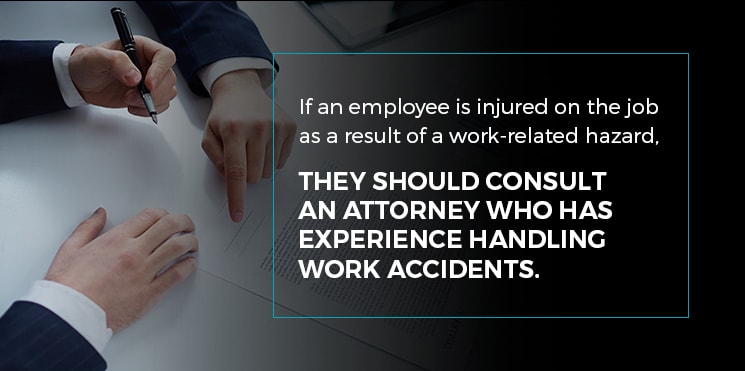By Larry Weisberg on January 23rd, 2017
What is safety culture? Why does it matter? How can businesses implement it?
Work safety should be primary importance to both employers and employees. Many workplaces offer safety training for new hires as part of their overall welcome and orientation. This is a good start, but talking about keeping safe shouldn’t be something that’s discussed once or confined to putting up a couple of posters in the lunchroom.
What Is Workplace Safety Culture?
Workplace safety culture refers to the way day-to-day matters are handled on the job. Employees have attitudes and values concerning on-the-job safety that they bring to work with them.
But a good safety culture starts with the attitudes held by the company’s managers. When senior management is committed to making and keeping the workplace safe, policies will flow from the top down. They will include:
- Being committed to safety daily
- Having specific practices for dealing with workplace hazards
- Creating opportunities for managers and workers to keep safety at the forefront through opportunities for continuous learning
- Making concerns about safety hazards a shared responsibility for everyone in the workplace
A good workplace safety culture doesn’t develop overnight. It has to be built over time, and reinforced with decisions managers and employees make. If a particular standard is set for company practices around handling hazards in the workplace, it needs to be maintained.
Employees and their supervisors need to have training on new safety equipment and refreshers on equipment they currently use. Safety training should be a continuous part of the work environment.
Safety in the workplace should be everyone’s business. The owners, managers, employees and contractors can all participate in creating the company’s safety culture. By working together, they can help to ensure that it’s a positive experience that benefits everyone in the organization.
Safety Legislation Helps Employers and Workers
The Occupational Safety and Health Act (OSHA) took effect in 1970 and covers public and private sector workers. The goal of this piece of legislation was to help ensure that employers provide a work environment that makes employee safety a priority.
OSHA was also responsible for establishing the Occupational Safety and Health Administration. The majority of US states have enacted either laws or regulations to either encourage or require employers to implement illness and injury prevention programs. Other states offer financial incentives to employers to offer them.
Depending on the state, these programs may apply as follows:
- All employers, regardless of size
- Employers who meet a particular threshold (either above or below a set number of employees)
- Employers who are deemed to be in “high-hazard” industries
- Employers with injury/illness rates that are above average for their industry
Employees benefit from the legislation because it protects their right to work in a safe environment. It also includes their right to safety protections under the Act.
Section 5 of the OSHA: Duties
This section of the OSHA covers the employer’s general duties under the law. It reads as follows:
Each employer shall:
- Furnish to each of his employees employment and a place of employment which are free from recognized hazards that are causing or are likely to cause death or serious physical harm to his employees
- Comply with occupational safety and health standards promulgated under this Act.
Each employee shall:
- Comply with occupational safety and health standards and all rules, regulations and orders issued pursuant to this Act, which are applicable to his own actions and conduct.
Employers are responsible for ensuring that they take measures which are considered reasonable and appropriate in the circumstances to protect their employees while on the job. They have a responsibility to be familiar with the type of protective clothing and gear that their employees would need, for example.
Not only would the employer have to be familiar with the appropriate safety clothing and equipment, but the company is also responsible for providing it when required for health and safety reasons.
Consult an Attorney About Employer Duties
If an employee is injured on the job as a result of a work-related hazard, they should consult an attorney who has experience handling work accidents. Further investigation will be required to determine:
- What caused the injury
- Whether the employer knew (or ought to have known) about the hazard
- Whether the hazard was something obvious or one that is familiar to people working in the industry
The hazard itself will be looked at to consider whether it is something that is likely to inflict a serious injury or lead to a person’s death. The hazard must be correctable.
An employment attorney will look at the facts of the case and offer advice about options for what a client can do if the employer failed to meet its duties to its employees under this section of OSHA.
Section 8: Keeping Records
Section 8 of OSHA requires employers to keep two different types of records:
- All work-related injuries that require a level of medical treatment higher than basic First Aid must be logged. Records must be kept for a minimum of five years.
- Regulations require employers to keep records of all non-consumer chemical products that are used in the workplace. Material Safety Data Sheets (MSDS) must be posted and made available for workers so that their contents can be read and actions taken to avoid hazards.
If an employee suffers an injury they suspect may be related to a chemical hazard in the workplace, they should consult with an employment attorney. The matter will need to be investigated to determine whether all chemical products were logged and information was provided to employees as directed under safety laws.
The employer may have behaved properly, but the product being used by an employee on the job may have been faulty, which led to an injury. In that instance, an attorney can advise the employee about their right to possible compensation from the manufacturer of the product.
Section 11(c): Protection for Employees Against Discrimination, Retaliation
This section of the law specifically protects employees from being “discharged or discriminated against” because they exercised their rights under the Act. These rights include making a complaint, seeking an official inspection, participating in an inspection or testifying in proceedings related to an Occupational Safety and Health Administration inspection.
An employee who has reason to believe they have been discharged or discriminated against because they exercised their rights under the Act should consult with an experienced employment attorney. The lawyer will review the facts of the case and offer advice based on the unique set of circumstances.
Section 18: States Can Adopt Their Own Safety and Health Plans
Each state is free to adopt its own safety and health plan, as long as it is at least equivalent in standards to the federal version. Businesses can adopt a health and safety policy for their employees, as well.
Why Do Businesses Need a Health and Safety Policy?
There are a number of reasons why businesses would want to adopt their own health and safety policy.
Show Employees That Their Safety and Security Is Important
If businesses want to hire and retain quality workers, they need to show their staff that they are valued. Paying their employees a fair wage and offering benefits are ways that companies can show their appreciation.
Good working conditions that are safe also show workers that they are of value to their employers. Providing proper safety clothing and equipment and ensuring it’s inspected regularly and replaced as needed also speak volumes about how well an employer thinks of its staff.
Employees who know they have someone they can share their safety concerns with, and that they will be listened to, are more likely to be motivated to perform well on the job. This is good for business, because employees who are happy and efficient boost the company’s bottom line. More profits mean the business operates better, and that ends up being a positive outcome for both employer and employee.
Makes the Workplace Less Stressful
Once a health and safety policy is in place and is being implemented, employees and managers can focus on their duties instead of being concerned that their physical environment at work is less-than-secure. Distracted employees are more likely to have an accident themselves, which ends up making the workplace a riskier place for fellow employees, managers, visitors and customers.
Reduces Employee Turnover
If a workplace is highly stressful, the turnover rate is likely to be much higher than if the atmosphere is more relaxed. High employee turnover due to more accidents than usual leads to increased costs in hiring and training new workers. To keep these costs down, investing in improving workplace safety and security measures makes more sense.
Health and Safety Policies Show a Business Wants to Be a Good Corporate Citizen
According to popular thinking, companies have a duty to care for the environment and their people by making good choices. They don’t simply pay wages as an exchange of value for services performed. Instead, companies invest in their people by ensuring they stay safe on the job.
Good companies that care for their people are transparent about these policies and let their customers know they have taken on this “duty of care” toward their employees.
Consumers Make Buying Decisions Based on Ethical Business Practices
Modern consumers are very aware that they have numerous choices about where they can spend their money. A number of them choose to do their homework and deliberately do business with companies that they feel operate in an ethical manner. To this group of buyers, that includes treating their workers well by implementing an effective safety culture.
A business that has a reputation, accurate or otherwise, of not treating its workers well may find it more challenging to increase sales and keep customers loyal.
If buyers can find similar products elsewhere that can be provided by a company with a better reputation for health and safety or general working conditions, some customers may decide to deal with the business that has the better reputation for safety.
Need to Stay Compliant With Legislation
One of the best answers to the question of “Why do businesses need health and safety policies?” is that they have a legal responsibility to comply with legislation relevant to these issues. If they fail to do so, they may face legal consequences.
How to Implement a Safety Program
The best place to start when thinking about how to implement a safety culture change in a business is to get managers and employees talking about the idea. Make sure employees understand why the plan is being implemented and why it’s important. Allow them to ask questions and voice concerns.
- Identify Hazards in the Workplace.
Have a manager and employee do a walkthrough of the workplace and note any existing hazards. Notice the way the workplace is currently laid out and the type of machines employees use, including the moveable equipment they use during the day.
Do they wear uniforms that may contribute to safety hazards, or does their street clothing present an issue on the job? Do things like jewelry or long hair present hazards at work? Are there items that need to be moved or secured to lower the risk of injury to workers?
- Learn About Legal Requirements From OSHA.
Find out about what a business must do to comply with existing laws to keep employees safe. Keep in mind that minimum standards should not be the goal, but rather a starting point when implementing a safety program.
- Put Together a Safety Program.
Create a safety program that applies to all workers. Get help from consultants and government resources as necessary to ensure the program covers safety hazards in the workplace and complies with relevant or industry-specific safety legislation.
- Make Sure All Employees Receive Safety Training.
Once the safety plan is in place, all workers must receive safety training. Workers need to know how the new standards will affect their work.
Once an employee has received the first round of safety training, a schedule for updated training should be provided. All workers should be encouraged to stay alert for any safety issues, whether the problem is directly in their work area or not. All employees are equally responsible for keeping the workplace safe.
- Conduct an Annual Safety Audit.
Every year, take the time to look at how well the business is doing regarding safety. Have there been any injuries or accidents? What can be done to improve?
- Have a Written Policy for Handling Employee Concerns.
Employees should always be encouraged to approach a manager to ask questions or share concerns. Once an issue is brought to a manager’s attention, it needs to be dealt with and the worker who brought it up should be informed about how the matter was resolved.
This type of open communication will encourage workers to continue to bring matters to their supervisors’ attention. A written policy included in the safety plan would let everyone in the company know how safety concerns will be handled.
If the employee is not satisfied with how a concern was dealt with by their supervisor, the employee should have some form of recourse. This should be clearly spelled out in the policy.
A well-written safety policy can help a business run more smoothly and prevent both inconvenience and harm before they slow down a company or even stop it in its tracks. It also needs to be followed by employees and managers, or the system will break down. But a company that puts worker welfare first, with a strong and safety-focused culture, will find its customers and employees more loyal and become more successful overall.





